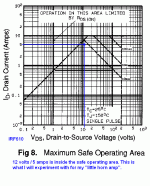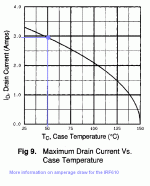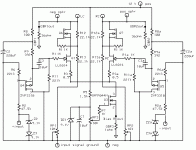It's nice to hear from you, Nelson; you're quite the mentor.🙂
In its current configuration, the little (and boy is it little) jfet ZV7-T can drive my horn to awesome levels. But there's the midbass section in my thoughts that will certainly require more horsepower--I'll be applying your advice in the near future.
With regards to the horn:
Because the heat levels are so low, I'm thinking I'd like to cascode a tiny signal jfet with the LU1014D. Or, in reverse, perhaps the LU1014D with a IRF610. This keeps my little baby--little.😉
In its current configuration, the little (and boy is it little) jfet ZV7-T can drive my horn to awesome levels. But there's the midbass section in my thoughts that will certainly require more horsepower--I'll be applying your advice in the near future.
With regards to the horn:
Because the heat levels are so low, I'm thinking I'd like to cascode a tiny signal jfet with the LU1014D. Or, in reverse, perhaps the LU1014D with a IRF610. This keeps my little baby--little.😉
Thats the way to go 🙂
I though wouldn't use IRFP044 as they are only 60v devices and besides that it will not make any difference to use an IFRP240 instead (well besides the lack of that popping sound).
and besides that it will not make any difference to use an IFRP240 instead (well besides the lack of that popping sound).
I ran mine on 44v instead of 30V, and around 3A per mosfet.
Magura 🙂
I though wouldn't use IRFP044 as they are only 60v devices
 and besides that it will not make any difference to use an IFRP240 instead (well besides the lack of that popping sound).
and besides that it will not make any difference to use an IFRP240 instead (well besides the lack of that popping sound).I ran mine on 44v instead of 30V, and around 3A per mosfet.
Magura 🙂
Magura said:And you can do without R1 (0R5)
Magura 🙂
Could do . . .
But I think that the original reason why LU1014D was to utilise
the triode spot (Vds about 2V). So, the potential difference
between the upper mosfet gate and the btm of the source R1
below LU1014D was 7V. And, 4V deduction from it for the upper
mosfet bias. And, remaing potential was 3V. But, for the triode
spot, 1V was to be further removed. BY THE source R1! In
addition, the source R could do negative feedback to the Vgs of
LU.
Tho might Nelson disagree . . .
Go back to diyfight, but don't do more showing your thumb down
towards diyAudio.

Magura said:Thats the way to go 🙂
I though wouldn't use IRFP044 as they are only 60v devicesand besides that it will not make any difference to use an IFRP240 instead (well besides the lack of that popping sound).
I ran mine on 44v instead of 30V, and around 3A per mosfet.
Magura 🙂
44 Volts! I'm impressed.🙂 And thanks for the encouragement, Magura.
I have bunches of the 044 transistors; that's one reason I use them. I also like their sonic signature.
I do have a fair share of the 240s, and since this is a cascode arrangement, I guess their sonics are no longer in the equation.
To be honest, I sure like the idea of keeping one version of this ZV7-J-T a low wattage creature. I'ts just amazing that I can have all this glorious sound and not have to worry about heat--there's just so little of it.
I remember reading (Borbely?) that R1 is useful for feedback. I also like to run these fellows in pair or triplets and thought the resistance would prevent current hogging.
Again, thanks.
Babowana, you managed to take my abstract thoughts and put them into words. Thank-you for doing that. I'm so new at this stuff that I'm relying partly on instinct and partly on inspiration. Nelson's ideas and you guys give me reason to feel inspired.
I thank-you for that.
John🙂 🙂 🙂
So, I'm in the throws of designing my "Little Horn Amp". The larger cascode amp will come later. What I've always wanted was a small, somewhat cool running, 5 watt amp for my paper-mache HF horns.
I'm considering the IRF610 for the other half of the cascode arrangement; it small, thus uses less energy to achieve bias. I'm submitting a chart from IRF for this device. It show 12 volts as being optimum for maximum current draw. Jfets are great a passing along current, if not voltage. For a little amplifier, this seems as good a place to start as any.🙂 I am a bit confused as to whether or not this refers to steady current draw.
I'm open to comments.🙂
I'm considering the IRF610 for the other half of the cascode arrangement; it small, thus uses less energy to achieve bias. I'm submitting a chart from IRF for this device. It show 12 volts as being optimum for maximum current draw. Jfets are great a passing along current, if not voltage. For a little amplifier, this seems as good a place to start as any.🙂 I am a bit confused as to whether or not this refers to steady current draw.
I'm open to comments.🙂
Attachments
carpenter said:
44 Volts! I'm impressed.🙂
John🙂 🙂 🙂
Well, no particular reason to be all that impressed about that. It's basicly just a matter of plenty of heatsinking.
For that sort of test setups I have approximately twice the amount of heat capacity, compared to Steenoe's AX-100 monoblocks. Simply just all the heatsinks that either got a dent or the like have ended up as the test heatsink....makes life easier 🙂
Magura 🙂
Carpenter, I've run 610s at about .5A and 20-25V on a good heatsink. Maybe short term playing around up to 15 Watts, on a good heatsink! I think thats about it 

Hi Lee,
What's weird is that the LU1014 jfet is twice as small (physically) as the 610, but supposedly handles twice the wattage. What's up with that?
I'm just going to try the 610s at 12 volts, 2 amps. I'll soon know if they can survive. There's always the 044s, but they want lots of bias wattage... I want a little horn amp. I want the big ones too, but first, "The little horn amp".
I'll explore IRF's website and see if I can find a transistor that's in between the 610 and 044.
Thanks for posting your thoughts and observations!
John🙂
What's weird is that the LU1014 jfet is twice as small (physically) as the 610, but supposedly handles twice the wattage. What's up with that?
I'm just going to try the 610s at 12 volts, 2 amps. I'll soon know if they can survive. There's always the 044s, but they want lots of bias wattage... I want a little horn amp. I want the big ones too, but first, "The little horn amp".
I'll explore IRF's website and see if I can find a transistor that's in between the 610 and 044.
Thanks for posting your thoughts and observations!
John🙂
carpenter said:Hi Lee,
What's weird is that the LU1014 jfet is twice as small (physically) as the 610, but supposedly handles twice the wattage. What's up with that?
John🙂
Well, those numbers for the LU1014 are HIGHLY optimistic! Pushing them harder than about 20W is a sure death of them. 10W is much closer to what they can deal with in the long run.
Magura 🙂
I'm sure you are correct, Magura! As configured, they barely get the heatsinks warm, although their sonic signature is exactly what I like.
I notice that IRF makes 630 and 640 style transistors. Their power rating is considerably larger than the 610. Still, this is only supposed to be a four/five watt experiment. If I want gobs of power (that's a technical term by the way😀 ) I'll go to the 044, or 240.
BTW, I've been running the 044 without a failure for quite some time now--they are wonderful sounding devices.
John🙂
I notice that IRF makes 630 and 640 style transistors. Their power rating is considerably larger than the 610. Still, this is only supposed to be a four/five watt experiment. If I want gobs of power (that's a technical term by the way😀 ) I'll go to the 044, or 240.
BTW, I've been running the 044 without a failure for quite some time now--they are wonderful sounding devices.
John🙂
carpenter said:
BTW, I've been running the 044 without a failure for quite some time now--they are wonderful sounding devices.
John🙂
I'm too running 044's pretty hard, but they sure do give up the ghost if pushed past 60V and that is hard to tell if they will be if inductor loaded at more than 25V or so.
Maguar 🙂
John, Re: 610s, Its a die size thing. To have a low C part you need a small die size. Small die size means you can't dissapte to much power. Isn't the 610 rated at 30W or something? And a Theta J of 4 DegreesC/W.??? 12 Watts * 4(D C/W) = 48 Degrees above Ambient with a decent H.S.! 





Hi Magura, hi Lee,
I've been using the 044s with a 27.5 volt supply. So far, so good. Hopefully, things will remain this way.
With regards to the 610, I'll just give it a little juice for now. I mean, the LU1014 is doing just fine in the circuit I presented, so I would imagine that the 610 won't be any worse for the wear.
I sold my Honda Prelude, so I have a few dollars to invest in my experiments😀 As happy as these discoveries make me feel, I'm certain it's a wise choice.😀 😀 😀 I can hardly sleep at night, my mind is so active.
I located IRF9630s at Apex Jr. for cheap: a hundred for $45.00, so maybe I'll just reverse the circuit and play with those. They'll take considerably more current. Jfets can be reversed, I read.
John🙂
I've been using the 044s with a 27.5 volt supply. So far, so good. Hopefully, things will remain this way.
With regards to the 610, I'll just give it a little juice for now. I mean, the LU1014 is doing just fine in the circuit I presented, so I would imagine that the 610 won't be any worse for the wear.
I sold my Honda Prelude, so I have a few dollars to invest in my experiments😀 As happy as these discoveries make me feel, I'm certain it's a wise choice.😀 😀 😀 I can hardly sleep at night, my mind is so active.
I located IRF9630s at Apex Jr. for cheap: a hundred for $45.00, so maybe I'll just reverse the circuit and play with those. They'll take considerably more current. Jfets can be reversed, I read.
John🙂
Why is it you are so focused on the input buffer instead of using a BOSOZ pre? just curious 😉
Magura 🙂
Magura 🙂
- Status
- Not open for further replies.
- Home
- Amplifiers
- Pass Labs
- ZV7-T (transformer)




